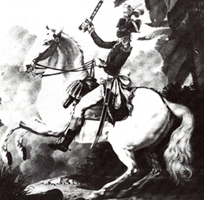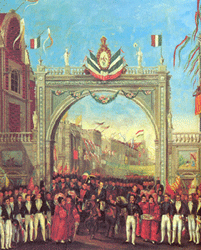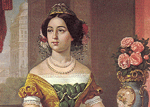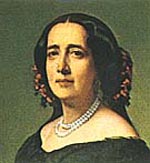Homework #6 Spring 2017 Baroque, Neoclassical, and early 19th century |
1. |
The online HUM 2461 textbook mentions Sor Juana's poetical masterpiece. (A) What is the title of this work. (B) What kind of literature is it? On page 5 of the Notes and Chronology page for Sor Juana, there are two links to this poem (one in English, the other in Spanish). Take a quick look at the poem (either Spanish or English translation) and give you opinion of the poem citing specific passages from the poem (quotations are required in this Question #1). |
|
2. |
See Section V, page 6, of the course's online Baroque Notes; it is dedicated to the Baroque in Brazil. Study these notes and then state what distinguishes the Brazilian Baroque period, as described in these notes, from the Spanish American Baroque period. |
|
3. |
Study the pages dedicated to Aleijadinho. Then study page #8 carefully. Write an answer to the following issue and comparison: The comments in #8 say that this humanities artifact is "quintessentially Baroque." (A) What elements makes is "quintessentially Baroque"? Give specifics. (B) Compare this "Pietà" with the classical image of the Virgen de Guadalupe known throughout the world and that hangs in the Basílica de Guadalupe in Mexico City; noting specifically whether or not the Virgen de Guadalupe image is Baroque. |
|
4. |
Study the pages dedicated to Aleijadinho. Then study page #10 carefully. Write a short and complete paragraph responding to the "humanities topic" embedded in this image. |
|
5. |
(A) Read the first paragraph (I) in the textbook document on the "Notes on 18th Century Latin American Precursors to Independence 1600 – 1810" (under "P" in the Index). (B) From the first paragraph (I), list three facts that stand out to you about the 17th and 18th centuries in Latin America as they relate to the coming of the 19th century independence movements (just make a list, no comments necessary). |
|
6. |
(A) Read the second paragraph (II) in the textbook document on the "Notes on 18th Century Latin American Precursors to Independence 1600 – 1810" (under "P" in the Index). (B) From the second paragraph (II), list three facts (just a list) that stand out to you about the "Conditions and reasons" found in the Latin America as they relate to the coming of the 19th century independence movements. |
|
7. |
First, review the online textbook's presentation on Fort Mose (near St. Augustine, Florida). (A) Taking into account what you have learned and your answers to Q7, Q8, and Q9 above (that is, about the 18th century in Latin America; after all, Florida was part of the Spanish America in that century), tell how the seemingly minor facts and history of Fort Mose (1738-1821) fit the historical patterns leading to Spanish- (and French-) America independence movements and wars from European empires. (Note: this question requires you to do some careful analysis and draw general conclusions based on specific facts: mention these facts as supporting evidence fory ou conclusions). |
|
8. |
A) Identify the figure in this painting. (B) Describe the painting as a humanities artifact in terms of the Latin American history and styles at the end of the colonial period and the beginning of the (revolutionary) Romantic period. (Note: you can find this image embedded in the "Notes on 18th Century Latin American Precursors to Independence 1600 – 1810" (under "P" in the Index).
|
|
9. |
In the notes on Latin American Romanticism, the author lists seven characteristics of this important humanities movement. List all seven (7) as stated therein. (Just write down the list.) |
|
10. |
In the HUM 2461 online textbook section on "Notes on 19th Century Latin American Independence Leaders and Movements
|
|
11. |
Answer the questions A-F embedded in the page on this Latin American Romantic portrait. (Find it in: --> "N" (Nineteenth Century) in the Index; and then --> in "Notes on Latin American Romanticism").
|
|
12. |
Compare and contrast these two portraits, both of which are in the "Notes on Latin American Romanticism: (A) |
|
13. |
Compare and contrast the portraits in the online textbook of Simón Bolívar (embedded in the page on him under "B" in the Index) and Hernán Cortés (embedded in his chronology under "C" in the Index; compare and contrast the content (meaning) contained in both portraits. |
|
14. |
(A) Read "Bolívar Document #1" in the notes and chronology of Simón Bolívar; then (B) tell briefly who he's writing to and what Bolívar says in this letter. |
|
15. |
(A) Read the poem (Spanish and/or English translation) titled "Chimborazo" by Simón Bolívar; (B) tell briefly what he's writing about; (C) conclude by pointing out two aspects in the poem that are typical of Latin American Romanticism. (For 1 point extra credit, tell what your reaction is to the fact that Bolívar was a general, an orator, and, now, too, a poet!) (Find the poem in a link under "Bolívar" in the Index. |





